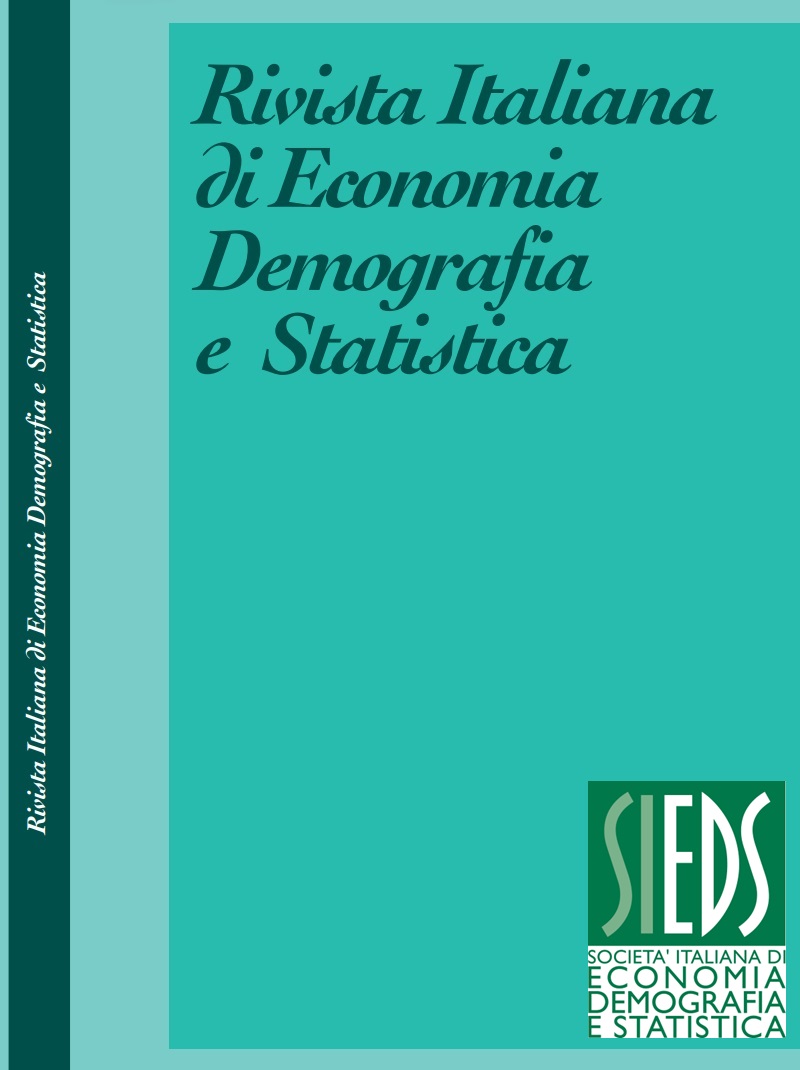Labour market and gender role stereotypes: the effects of the pandemic
DOI:
https://doi.org/10.71014/sieds.v79i2.338Abstract
Women have always participated in the labour market, though their roles and the social recognition have varied across different periods and cultures. Despite major changes from the industrial revolution, the world wars, women's rights movements, and laws promoting equal opportunities, gender stereotypes and inequalities persist and seem deeply rooted even in societies regarded as “advanced” and democratic. From an occupational and social perspective, the pandemic may have been a turning point. The shift towards flexible work and increased demand in certain sectors may have given women more job opportunities and encouraged them to rethink gender stereotypes. This study aims to explore the social and occupational impacts of the pandemic. To achieve this, the study will use official statistical data and apply normative, positive, and statistical analysis methods.
References
BUCAY J. 2008. El elefante encadenado, Barcelona, Serres edicione SL.
CAMERA DEI DEPUTATI 2023. L’occupazione femminile. https://documenti.camera.it/leg19/dossier/pdf/PP004LA.pdf
CARRIERO R., TODESCO L. 2016. Indaffarate e soddisfatte. Donne, uomini e lavoro familiare in Italia. Roma: Carocci.
COCHRAN W. G. 1954. “Some Methods for Strengthening the Common Chi-Squared Tests” Biometrics, Vol. 10, No. 4, pp. 417–51. DOI: https://doi.org/10.2307/3001616
CONSORZIO UNIVERSITARIO ALMALAUREA E ALMADIPLOMA 2024. Gender gap tra formazione e mercato del lavoro https://www.almalaurea.it/news/focus-gender-gap-2024
DEL BOCA D., OGGERO N., PROFETA P. E M. ROSSI 2020. “Women’s and men’s work, housework and childcare, before and during COVID-19” Rev Econ Household 18: 1001–1017. DOI: https://doi.org/10.1007/s11150-020-09502-1
DIPARTIMENTO DELLE PARI OPPORTUNITÀ e ISTAT 2019. Gli stereotipi sui ruoli di genere e l’immagine sociale della violenza sessuale - anno 2018. 25 novembre 2019. Roma: Istat.
FARINELLA D. 2019 Ciclo di seminari “Violenza di genere: conoscerla, prevenirla, riconoscerla e contrastarla” Università degli Studi di Messina - Dipartimento di Scienze Politiche e Giuridiche organizzato
FERRARIO T., PROFETA P. 2020. COVID: un paese in bilico tra rischi e opportunità. Donne in prima linea, in Laboratorio Futuro, Istituto Toniolo.
FERRARIO T., PROFETA P. 2021. COVID: la crisi più dura per le donne in un Paese ancora senza parità https://www.laboratoriofuturo.it/ricerche/covid-la-crisi-piu-dura-per-le-donne-in-un-paese-ancora-senza-parita/
FARVAQUE N. 2013. Developing personal and household services in the EU: A focus on housework activities, Report for the DG Employment, Social Affairs and Social Inclusion, ORSEU.
FILÌ V. 2021. Le difficili libertà delle donne tra gender wage gap, soffitti di cristallo e bassa fecondità, Lavoro diritti europa – Rivista nuova di diritto del lavoro 2.
GÓMEZ, V., MARAVALL, A. 1997. Guide for Using the Programs TRAMO and SEATS, Beta Version. Madrid: Banco de España.
ISTAT 2014. Giovani generazioni nel mercato del lavoro in Italia. https://www.istat.it/it/files/2014/10/focus-giovani.pdf
ISTAT 2019. I tempi della vita quotidiana. Lavoro, conciliazione, parità di genere e benessere soggettivo. Roma: Istat [ebook]
ISTAT 2021. Esame del disegno di legge n. 2144. https://www.istat.it/it/files//2021/04/Istat-DL-SOSTEGNI-aprile-2021.pdf
ISTAT 2023. Stereotipi di genere e immagine sociale della violenza: primi risultati. Dati provvisori maggio-luglio 2023. Statistiche today, Roma: Istat.
KOFMAN E., PHIZACKLEA A., RANGHURAM P., SALES R. 2000. Gender and International Migration in Europe. London: Routledge.
LAGOMARSINO F. 2004. Esodi e Approdi di genere. Famiglie transnazionali e nuove migrazioni dall'Ecuador. Milano: Franco Angeli.
MANTEL N., W. HAENSZEL 1959. “Statistical Aspects of the Analysis of Data from Retrospective Studies of Disease.” Journal of the National Cancer Institute Vol. 22, No.4, pp. 719–48.
MENNITI, A., DEMURTAS, P. 2012. Disuguaglianze di genere e attività domestiche. IRPPS Working Papers, Vol. 47, pp. 2-45.
NYMAN, C., REINIKAINENB, L., ERIKSSON, K. 2018. The tension between gender equality and doing gender Swedish couples' talk about the division of housework. Women’s Studies International Forum, Vol. 68, pp. 36-46. DOI: https://doi.org/10.1016/j.wsif.2018.01.010
POLETTI F. 2023. In Italia 143 senior ogni 100 junior, ma per i giovani lavoro in crescita, Il Sole 24 Ore, Econopoly, 31.05.2023. https://www.econopoly.ilsole24ore.com/2023/05/31/lavoro-giovani-istat/?refresh_ce=1
RAPANELLI, I. 2023. “Nuovi lavori, nuove alienazioni, nuove strategie di sopravvivenza. Ridefinire il lavoro nell’era post pandemica.” Heteroglossia. Quaderni di Linguaggi e Interdisciplinarità, 19, 185-202.
RISOLUZIONE DEL PARLAMENTO UE del 13 settembre 2016, P8_TA (2016) 0338.
TODESCO L. 2013. Quello che gli uomini non fanno. Il lavoro familiare nelle società contemporanee. Roma: Carocci.
UNITED NATIONS. 2015. Sustainable Development Agenda, Goal n. 5 “Gender Equality”.
VERRECCHIA F. 1993. Alcuni aspetti dello stato di salute della popolazione lombarda negli anni '80, Università degli studi di Milano, Milano.
Downloads
Published
Issue
Section
License
Copyright (c) 2025 Arianna Carra, Paola Maddalena Chiodini, Concettina Impallomeni, Elena Sorba, Flavio Verrecchia

This work is licensed under a Creative Commons Attribution 4.0 International License.



